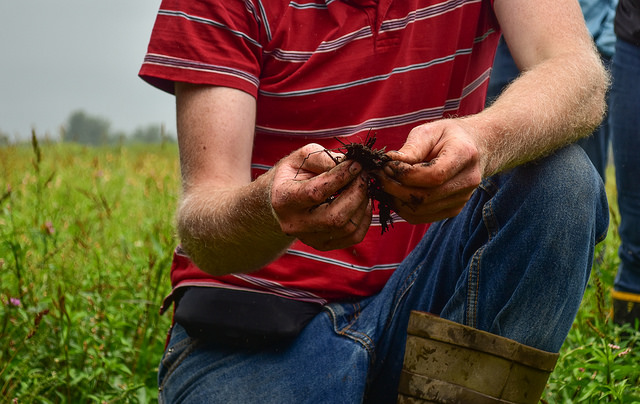
The 39th Ecological Farming Conference will start off with an in-depth look into the foundation of healthy farming systems: soil health and fertility. Vibrant soil is found at the intersection of biological, physical, and chemical parameters that shape the ability of plants to thrive and produce abundant and nutritious crops. Growers can influence the parameters to achieve superior results for plant growth and crop health.
The first part of the double session will detail how to interpret soil mineral analyses to target which amendments are the best for specific crops. Our widely-known presenter, Amigo Bob Cantisano, has more than 40 years of experience in advising organic farmers of many scales and crop types on how to use soil testing to determine the most cost-effective, biologically active, and nutrient-rich substances to improve their soil fertility. Topics include increasing nitrogen, phosphorus and potassium in the soil appropriately, balancing cations to maximize biological activity, and cultural practices that influence soil structure and bio-nutrient availability. Application methods for short and long-term release will be discussed. Learn how to wade through some claims made by fertilizer sales people to identify the products that provide the most value for each field's soil type and nutrient status.
Photo credit: Kath Clark/USC Canada
In the second section of the morning, participants will hear some of the latest research on managing fertility in two of the most common crops in coastal California: leafy green vegetables and strawberries. Vegetables have a high demand for nitrogen for a short period of time while strawberries require smaller amounts of nitrogen over a longer period of time.
Research into each of these situations and crops will be presented by Richard Smith, from UC Cooperative Extension in Monterey County and Joji Muramoto from UC Santa Cruz. This detailed look at vegetables will cover how to effectively manage nitrogen through efficiently managing a nitrogen budget, efficiently managing placement of dry fertilizers and irrigation management regarding liquid fertilizers, and maximizing nitrate nitrogen in the root zone to allow uptake at optimal times in crop growth. Strawberries have a quite different nitrogen demand cycle than vegetables and are often used in rotation with them. Some of the issues are how to avoid nitrogen immobilization in fall and winter so plants get off to a good start, how to supply a steady amount of nitrogen throughout the long growing season, and how to avoid excessive nitrogen that can lead to disease and pest problems.
Both sections of this workshop are oriented to both beginners who need to start understanding their soil and its role in crop health, and to those who already have growing experience but want to find out more about the latest thinking and research on organic practices.
Part 1 is on Thursday, January 24 from 8:30 to 10:00 am
Part 2 is on Thursday, January 24 from 10:30 to noon
Register for EcoFarm to attend this workshop
About Zea Sonnabend
For the past 35 years, Zea Sonnabend has been an organic farmer, gardener, inspector, educator, policy specialist, organizer, and consumer. She operates Fruitilicious Farm in Watsonville, CA with 20 acres of mature and young apples, figs, citrus, quince, pears, and blueberries. She also works as an organic inspector and Policy Specialist for California Certified Organic Farmers. She served on the National Organic Standards Board (NOSB) from 2012 to 2017. Other activities include participation on the Crops Review Panel for the Organic Materials Review Institute and past organizer and current advisor to the EcoFarm Conference.
